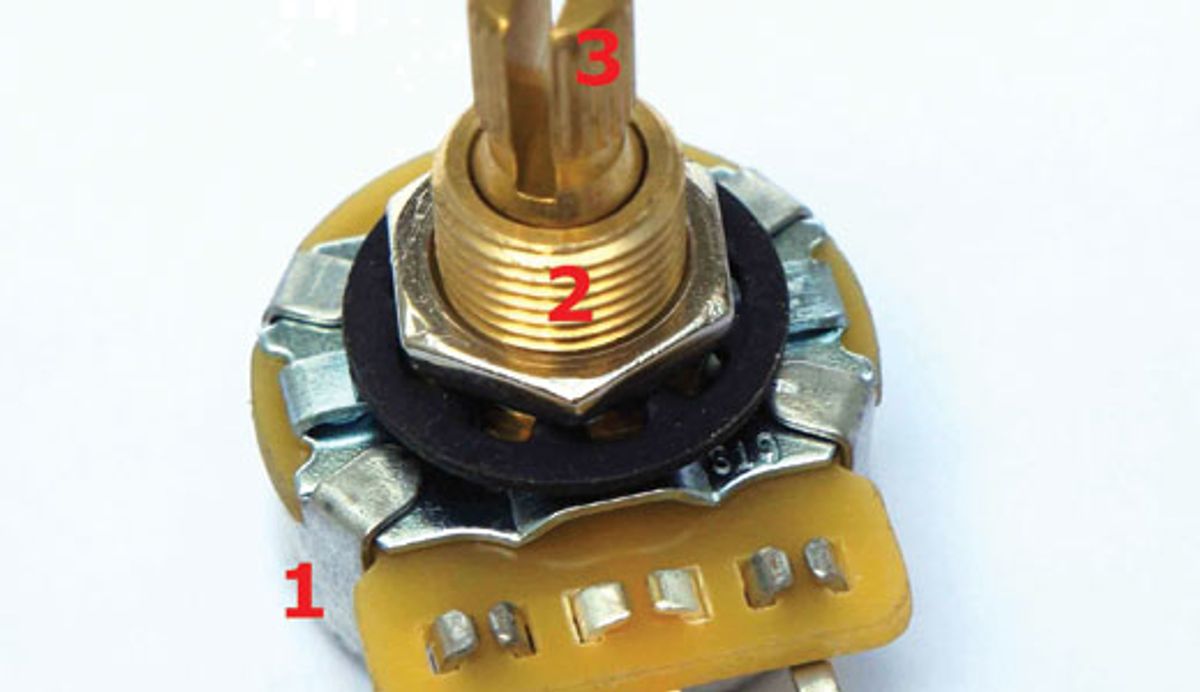
Photo courtesy of singlecoil.com
Potentiometers are small and cute, but it pays to know their anatomy.
If you're a Trekkie like me, you instantly know what my headline refers to: “The Trouble with Tribbles," episode #44 from the original Star Trek's 1967 season. In our shop, we call potentiometers (“pots") tribbles because those cute little rascals can cause enormous trouble. So here are some guidelines to help you avoid ending up like Captain James T. Kirk in this iconic episode.
Almost all electric guitars have one or more pots to control volume and tone, or for such special uses as blending two pickups. Unfortunately, it's usually not a question of whether a pot will fail—only when. Pot problems can range from crackling to non-responsive controls, or even a dead guitar. Sometimes noisy pots can be cleaned or repaired, but often the only remedy—especially with cheap factory pots—is to change them.
Changing a pot isn't difficult—it's usually just a matter of locating an identical part and duplicating the original solder connection. But I get at least five emails a day from guitarists who aren't sure how to determine the correct part for their needs. We'll shed some light on that, but first, let's look at the parts that make up a pot.
Pot anatomy. Let's be sure we're using the same terminology. Photo 1 shows the main parts of a typical pot. As you can see, the part names are far from standardized.
1. The casing (also called housing, case, body, or enclosure).
2: The bushing (also called threaded collar or shank).
3: The shaft (occasionally called top).
There are other parts (terminals, baseplate, nut, washer, etc.), but let's focus on these three main ones. When seeking a replacement pot, sometimes the guitar model name is all you need. For example, searching “vintage Strat" will probably locate the correct pots. But in other cases, you must know additional parameters, namely: measurement type (U.S. inch vs. metric), nominal resistance, casing diameter, bushing length and diameter, and shaft type and diameter.
Parallel universes. Most U.S.-made guitars (like Fender, Gibson, and PRS, to name a few) use U.S. pots measured in inches. Meanwhile, most guitars produced outside the U.S. (Epiphone and Ibanez, for example) employ metric pots. Some companies (like leading American pot manufacturer CTS) only make U.S. inch pots, while other brands, such as Alpha and Bourns, build both types, so be careful when choosing replacements.
will fail—only when.
Nominal resistance.This is often referred to as the pot's “value," with 250k, 500k and 1M as the standards for passive guitars, while and pots with values between 10k and 50k are common in active circuitry. The resistance is usually stamped on the casing or baseplate. If you can't find the info, remove all wires from the pot and test it with a standard digital multimeter (DMM) set to resistance. You may also be able to identify the pot value from a wiring diagram on the manufacturer's website.
Casing diameter. Usually only two pot sizes are used in guitars: big ones (standard) and small ones. The standard big size is .937" (approximately 23.8 mm) and 24 mm for metric pots. The small size is .650" inches (about 16.5 mm) and 16 mm for metric. Your measurements can indicate whether you have a metric or U.S. inches pot.
Bushing length and diameter. There are three common bushing lengths, often referred to as short, semi, and long. Short pots are usually installed through a pickguard or metal control plate, as on Strats and Teles. Their size is .250" (about 6.35 mm), and 6 or 6.5 mm in metric. Semi pots are for installation through wood, as on an SG or PRS. These are .375" inches, or 3/8" (roughly 9.5 mm), and 10 mm in the metric version. Long pots are used with thick wooden tops, like on a Les Paul. These are .750" (about 19.05 mm) and 20 mm in the metric version.
Luckily, there are only two common bushing diameters: 3/8" (about 9.5 mm), with a 10 mm metric equivalent. A thinner version (often found on pots with the smaller casing) is 0.31" (8 mm). The metric versions are 8 mm as well.
Shaft type and diameter. There are two shaft types: split-shaft (for push-on knobs, as on a Stratocaster) and solid-shaft for knobs with a set screw (like a Telecaster's dome knobs). On U.S. inch pots, the typical split shaft's diameter is .236" (about 5.95 mm) with 24 “fine-knurled" teeth, and the metric version is 6 mm with 18 “coarse knurled" teeth. Careful when replacing push-on knobs for split-shafted pots—you can't push knobs made for 18 teeth onto shafts with 24 teeth, and vice versa. (You can fine-tune the fit by squeezing the shafts together slightly or spreading them further apart.) A U.S. inch solid shaft is .250" (approx. 6.35 mm) while the metric version is 6 mm.
Pot-mounting hardware. Finally, to install pots into a guitar or pickguard, just follow these steps: Remove all the hardware. If you need to adjust the height of the pot in the pickguard or the guitar, thread on a spare hex nut to use as a spacer. Then install the lock washer. Insert the pot into the pickguard or guitar. Place the washer on the bushing. Secure the pot with a hex nut. That's it!
Next month we'll explore a cool mod for Les Paul/SG/335 lovers. Until then, live long and prosper ... and keep on modding!

